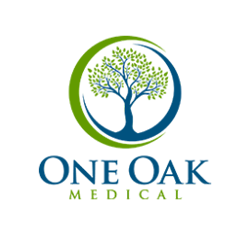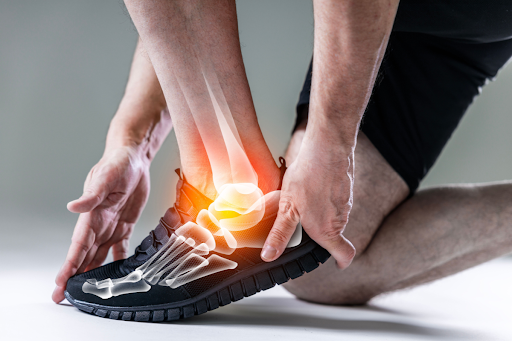Most Common Foot Problems: Why the Bottom of Your Foot Hurts!
Your feet are under constant pressure from when you wake up to when you go to sleep at night. Every step forces your bones, ligaments, and tendons to absorb the impact that compounds over time. When movement exceeds the normal range, your tissue stretches beyond its limit. That’s when a sprain or strain sets in, causing you to feel discomfort almost immediately. Sprains affect ligaments, those bands of connective tissue holding joints together, while strains target your muscles or tendons. Either way, pain arrives fast, with swelling soon to follow and bruising not far behind.
Knowing how to identify the most common foot conditions and what you can do about them with One Oak Medical’s help can protect your long-term quality of life. Let’s dive into some of the most common foot problems and get to the bottom of your foot pain.
Sprains & Strains
Injuries such as sprained ankles, overstretched plantar fascia, and pulled calf muscles can significantly disrupt an individual’s gait, leading to discomfort and mobility issues. When faced with these conditions, physical therapy becomes an essential part of your recovery process. A trained physical therapist can develop a tailored rehabilitation program to restore strength, flexibility, and overall functional movement. Simultaneously, a consultation with a podiatrist may be warranted.
To facilitate healing, conservative measures like ice packs, resting the affected area, and applying compression can be beneficial in managing pain and reducing inflammation. Over-the-counter medications, such as ibuprofen, can further alleviate discomfort while addressing inflammation in the short term. However, it’s crucial to understand the potential long-term consequences if these injuries are not adequately treated. Repeated strain on already compromised tissues increases the risk of developing more serious conditions, including stress fractures and long-term joint instability. Ultimately, stability begins with appropriate support, making addressing immediate and long-term rehabilitation needs imperative.
Nerve Entrapment Syndrome
Ever feel burning, tingling, or shooting pain in your foot? That’s what nerve entrapment feels like. When soft tissue swells, nerves get trapped between bones and ligaments, resulting in discomfort that won’t quit. The pain can mimic a sports injury, but this isn’t a simple bruise that you can ice and rest. One of our physicians may recommend corticosteroid injections, physical therapy, or, in severe cases, foot and ankle surgery to address your condition.
Ligament Laxity
Ligaments hold the foot’s structure together, and when they loosen, your stability suffers. Loose ligaments increase the risk of ankle fractures, sprains, and repetitive strain injuries that significantly affect your quality of life. Some of the most common examples of ligament laxity include when the arches of the foot flatten, altering how weight distributes. Pressure on the calcaneus leads to heel pain that causes the ankle to wobble under strain. When your gait changes to adjust to weakness, hip and knee pain soon follow.
Physical therapy can help tighten ligaments, improving your range of motion. But ignoring the issue invites progressive deformity. Bunions, hammertoes, and joint misalignment worsen over time, which means that accessibility to the right treatment options matters more than ever. If pain persists, one of our podiatrists will explore surgical options with you to find the option that works best for you.
Gait Disorder
How you walk affects your entire body, and an abnormal gait throws everything off balance. Chronic pain, inflammation, and increased risk of stress fractures are a result of your developing gait disorder. A podiatrist from One Oak Medical can diagnose underlying issues through magnetic resonance imaging or gait analysis so we can make a more informed decision regarding your treatment options. Sometimes, foot and ankle surgery becomes necessary to address your gait-related issues. More often, therapy and custom orthotics correct posture. Our staff helps determine the most effective treatment plan for your specific gait issues.
Hammertoe Contracture
A hammertoe bends at the middle joint, locking the toe in a curled position. Over time, stiffness worsens. Corns, calluses, and ulcers form due to constant friction. The condition often results from muscle imbalance. Weak tendons can’t keep toes straight. The problem? Pain increases with movement. Wearing tight shoes exacerbates the issue. Arthritis, bunions, and nerve disorders make things worse. Treatment options vary, and our team may recommend everything from foot exercises to splints and antifungal treatments for secondary infections to address your condition. Severe cases require orthopedic surgery, and we’ll help you through every stage of the diagnosis and treatment. Keeping joints mobile is crucial; ignoring the issue can lead to long-term problems.
Tarsal Tunnel Syndrome
Think of tarsal tunnel syndrome as carpal tunnel’s cousin, except in the foot. The posterior tibial nerve, running along the inside of the ankle, gets compressed. Symptoms include burning pain, numbness, and tingling. Running, weight-bearing exercises, or even standing for long periods worsen discomfort. Peripheral nervous system issues like diabetes increase susceptibility. If left untreated, nerve damage can become permanent. Treatment options include corticosteroid injections, physical therapy, and foot orthotics. However, surgery may be required to deal with the condition if symptoms persist. Accessibility to proper care makes a difference. The right footwear reduces pressure. Motion control inserts prevent worsening irritation. Nerve entrapment conditions don’t resolve themselves. Early intervention stops the damage from spreading.
Turf Toe
While turf toe is usually associated with an on-the-field injury, this particular condition isn’t just an athlete’s problem. Hyperextension of the big toe joint causes ligaments to stretch or tear, leading to immediate and intense pain. While it feels like a sprain, turf toe affects movement differently. Pushing off the foot for power and even basic movement becomes a challenge while walking barefoot worsens the issue.
Turf toe often results from repetitive strain injuries, leading to increased risk for athletes, dancers, and individuals with high-impact lifestyles. Swelling and bruising indicate soft tissue damage. Treatment involves rest, ice packs, and sometimes splints, while in some cases we may recommend physical therapy to restore joint function based on the severity of the injury. Ignoring the condition prolongs recovery and becomes a more serious issue.
Why Trust One Oak Medical With Your Foot Problems
At One Oak Medical, our expertly trained podiatrists offer cutting-edge treatments for various foot conditions. Expert care makes a difference in your long-term recovery, whether it’s a sprained ankle, plantar fasciitis, or nerve entrapment. From physical therapy to orthopedic surgery, solutions exist that are ideal for your specific conditions and give you the targeted treatments you need. Our patients trust us because of our proven track record of delivering personalized treatment plans for each of our patients. Every foot problem has a solution, and the key is to address it early.
Schedule Your First Consultation for Your Foot Condition Today
Foot pain shouldn’t dictate your long-term mobility. Whether it’s a stress fracture, bunion, or soft tissue injury, One Oak Medical provides the highest level of foot and ankle care in New Jersey. Foot health impacts the entire body, and every movement matters, from joint stability to gait mechanics. Patients receive customized treatment plans addressing specific conditions, and we work with them through every step of the diagnosis and treatment process to give them the relief they need. Schedule an appointment and take control of your foot health today.

